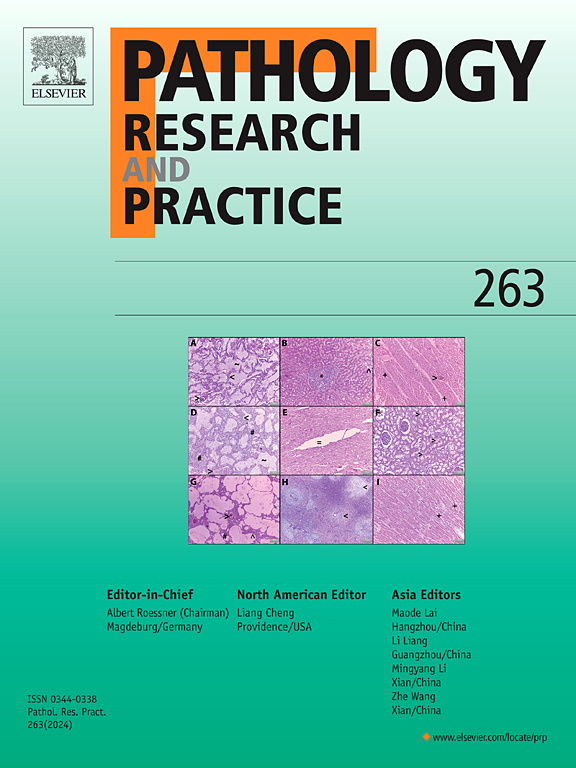USP32稳定SEMA4C促进结肠癌细胞的恶性行为
IF 3.2
4区 医学
Q2 PATHOLOGY
引用次数: 0
摘要
结直肠癌(CRC)是一种常见且致命的恶性肿瘤。SEMA4C已被发现可促进结直肠癌的进展,尽管SEMA4C在结直肠癌组织中表达的调控机制尚不清楚。在这项研究中,我们检测了40种可能影响SEMA4C稳定性的泛素特异性蛋白酶(USPs),并鉴定出USP32是一种有效的稳定剂。通过生物信息学分析,我们发现USP32 mRNA在结直肠癌组织中表达升高。抑制USP32导致细胞活力下降,细胞周期停滞,迁移和侵袭能力降低,以及与上皮-间质转化(EMT)相关的蛋白质水平降低。USP32直接与CRC细胞中的SEMA4C相互作用,其敲低可增强SEMA4C泛素化并加速其降解。此外,USP32通过调节其K48泛素化来增强SEMA4C的蛋白稳定性。过表达SEMA4C增强了usp32缺陷CRC细胞的恶性行为。这些结果表明,USP32通过稳定SEMA4C在结直肠癌中发挥癌基因的作用,揭示了结直肠癌发病机制的新机制,提示USP32可能成为结直肠癌治疗的潜在新靶点。本文章由计算机程序翻译,如有差异,请以英文原文为准。
USP32 stabilizes SEMA4C to promote malignant behavior of colon cancer cells
Colorectal cancer (CRC) is a prevalent and deadly malignancy. SEMA4C has been found to promote CRC progression, although the regulatory mechanisms behind SEMA4C expression in CRC tissues remain elusive. In this study, we examined 40 ubiquitin-specific proteases (USPs) that may influence SEMA4C stability and identified USP32 as a potent stabilizer. Through bioinformatics analysis, we discovered that USP32 mRNA expression is elevated in CRC tissues. Suppressing USP32 led to decreased cell viability, cell cycle arrest, reduced migration and invasion capabilities, and lower levels of proteins associated with epithelial-to-mesenchymal transition (EMT). USP32 directly interacts with SEMA4C in CRC cells, and its knockdown heightened SEMA4C ubiquitination and accelerated its degradation. Moreover, USP32 enhances the protein stability of SEMA4C by regulating its K48 ubiquitination. Overexpressing SEMA4C strengthened the weakened malignant behaviors of USP32-deficient CRC cells. These results indicate that USP32 acts as an oncogene in CRC by stabilizing SEMA4C, highlighting a new mechanism in CRC pathogenesis and suggesting USP32 as a novel potential therapeutic target for CRC treatment.
求助全文
通过发布文献求助,成功后即可免费获取论文全文。
去求助
来源期刊
CiteScore
5.00
自引率
3.60%
发文量
405
审稿时长
24 days
期刊介绍:
Pathology, Research and Practice provides accessible coverage of the most recent developments across the entire field of pathology: Reviews focus on recent progress in pathology, while Comments look at interesting current problems and at hypotheses for future developments in pathology. Original Papers present novel findings on all aspects of general, anatomic and molecular pathology. Rapid Communications inform readers on preliminary findings that may be relevant for further studies and need to be communicated quickly. Teaching Cases look at new aspects or special diagnostic problems of diseases and at case reports relevant for the pathologist''s practice.

 求助内容:
求助内容: 应助结果提醒方式:
应助结果提醒方式:


